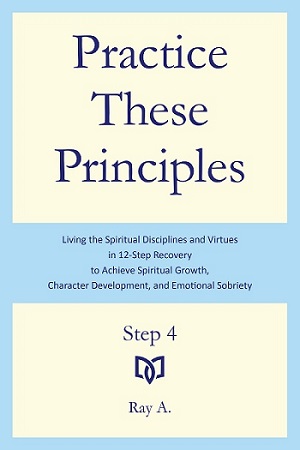
“A moral inventory is an examination of our character defects and the emotional liabilities associated with them. These are described in the Big Book as manifestations of self, of our spiritual malady of selfishness and self-centeredness. Elaborating on this fundamental AA premise, the 12&12 describes them further as representing “instincts gone astray.” These are understood as innate drives and natural desires that are essential to our survival and wellbeing. Their selfish pursuit causes them to exceed their “God-given” purpose and get “out of joint” (p. 42), turning them into the physical, mental, and spiritual liabilities that account for most of our emotional difficulties and the problems that we face in life.
In Step 4 we seek to discover what these liabilities are, the ways in which, under the relentless drive of distorted instinct, self becomes manifest in our lives. We seek to make a survey of our conduct with regard to our primary instincts, which using a handy mnemonic formula the 12&12 broadly identifies as our instincts for “sex, security, and society” (p. 50). This provides the conceptual and organizational framework in which to build our inventory. It guides us as we try to answer the practical question of exactly how to go about taking inventory of ourselves.
The Big Book suggests we start by zeroing in on anger, fear, and resentment, three emotions that are especially troublesome for alcoholics and which, if left unexamined, may lead us back to the bottle. It therefore takes these three emotions as the subject of what an initial inventory might look like and provides us with a sample, introducing a basic format that can lend itself to inventories of other emotional and character defects.
Components of Inventory
We will therefore examine this Big Book sample closely. We will try to flesh it out and build on it in the context of the full text of Step 4 in that work. While we will make some necessary references to the 12&12, we will leave a full exploration of Step 4 in that book for the next chapter, where we will seek to reconcile the two texts and show that they complement each other. The Big Book sample is reproduced below. Inside borders have been inserted for clarity.
. . .
In the sample we are given three columns, listing the persons we are angry at, the cause, and the things about us that are affected. To facilitate our discussion, let us refer to the one doing the inventory in the third person. Let us call him Anonymous John and name his wife Jane. Let us also deduce, as we can from the context, that the main setting is the workplace.
John lists a series of resentments against four people: two co-workers, his boss, and his wife. Starting with Mr. Brown, he gives three reasons for his resentment: Brown seems to be paying too much attention to Jane, told her that John was having an affair with another woman, and appears to be jockeying for John’s position at the office. The first two of these situations affect John’s personal and sex relations, the third his job and material security, and all three his self-esteem and thus also his emotional security.
Seeing these things “hurt or threatened” (p. 65) in the various situations involving Mr. Brown, John reacts not only with anger and resentment (to the hurt), but also with fear (to the threat). These three emotions in fact are aroused in the situations involving the other individuals as well, all of which affect John in areas that are personally important to him.
This is obviously the case with anger, since it is the basic emotion underlying resentment. But it is equally the case with fear, which the Big Book notes in parenthesis next to the affected area. This interplay between “Cause” and “Affects,” which by implication is what triggers these three emotional reactions, may trigger still other emotions. It would be useful therefore to replace the parenthesis with a full, fourth column. This will allow us to list what these other emotions might be and, along with our fears, review them “thoroughly” (p. 68).”
– From Part I: Taking Inventory, Chapter 2: The Big Book Sample, pp. 21-23